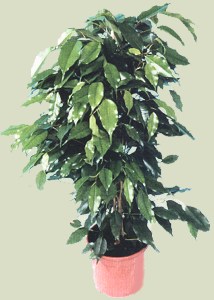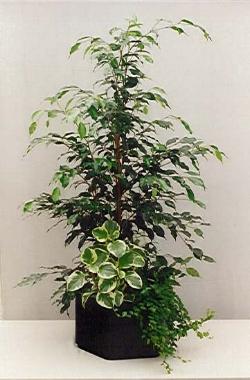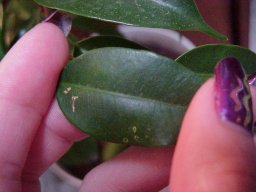|
Plants
for your home
(By Mary Efanti)
Ficus Benjamin
Origin - Description
 The most common
houseplant, we see it everywhere there are plants, in houses and workplaces as
well. The most common
houseplant, we see it everywhere there are plants, in houses and workplaces as
well.
Benjamin is a plant with rich, thin oval-shaped leaves, and tree-like growth. It belongs in the ficus
family, and more specifically in Moraceae family. It is a tropical plant in
origin, native to Malaysia.
Cultivation
Benjamin is a typical houseplant but in our country, it does very well in pots
outside, and reaches impressive growth if its container is large enough, and if you provide for its
needs.
If cultivated inside, make sure that the pot has good drainage in order to prevent root
rot. You could also plant it in large containers together with other plants.
Care
Benjamin needs plenty of light. So place it at a well-lit spot, but avoid direct
sunlight, on your balcony or through windows, especially during summer, because its leaves might get
sunburned.
All plants tend to reach for the sun, so in order to avoid a leggy plant, turn the pot by 45o every time you water
it. Keep in mind that benjamin is extremely sensitive to every minute change of conditions and the amount of light it
gets. So, if you change its position, expect him to complain with yellow dropping leaves and delayed development for at least a few days or until it gets used to the new
conditions.
You might notice the same symptoms after changing the pot. Change its pot only when the roots show up on the surface of the soil and try to bother the roots as little as possible during this
procedure. However, if the pot or the plant is very large and you cannot move
them, remove some of the topsoil and replace it or add some fresh soil on top.
Clean its leaves by spraying with lukewarm water or use a soft cloth or sponge as often as you
can, in order to remove dust and facilitate photosynthesis. Use leaves polishing sprays only if necessary because these sprays block the stomata
(little holes through which the leaves breathe). Remember that if you keep the leaves clean they are quite shiny
anyway.
Water only when the topsoil is dry to the touch. If benjamin is in a pot inside your
home, you must increase the moisture of the room during the winter. An easy way, which however does not seem to be
adequate, is to place metal containers with water on your radiators and spray its leaves with lukewarm water as often as
possible. The best solution is to place the pot on a tray filled with pebbles. You put water inside the tray and as it
evaporates, the leaves will absorb the moisture. In this case, make sure that the pot stands on the pebbles and not in water so that the roots do not
rot.
 Use liquid fertilizers during spring and summer until September or
October, approximately every 15 days, or according to the instructions written on the
packaging. Benjamin also needs extra iron in order to maintain its vivid green
color, so get iron in liquid or tablets form and use it according to the instructions on the
packaging. Remember that “more” is not always “best”. If the leaves turn yellow or show yellow
spots, this is could mean an iron deficiency. If the symptoms are severe, spray its leaves with liquid iron diluted in lukewarm
water, always according to the instructions on the packaging. Use liquid fertilizers during spring and summer until September or
October, approximately every 15 days, or according to the instructions written on the
packaging. Benjamin also needs extra iron in order to maintain its vivid green
color, so get iron in liquid or tablets form and use it according to the instructions on the
packaging. Remember that “more” is not always “best”. If the leaves turn yellow or show yellow
spots, this is could mean an iron deficiency. If the symptoms are severe, spray its leaves with liquid iron diluted in lukewarm
water, always according to the instructions on the packaging.
In spring, you will see lots of new growth, new leaves and
thin, straw-sized branches, but not all of them survive. Prune those thin branches that dry out and remove any yellow
leaves, so that the plant can use its energy for the healthy branches.
You will notice a thick white liquid coming out of the cut branches, much like the one we usually notice when we cut field poppies in
spring. This liquid might cause a slight itch to certain people so try not to touch it and wash your hands thoroughly after
pruning.
If your benjamin is getting taller than you wish, pinch the top growth. As a
result, more energy will be channeled to lower branches and you will get a bushier
plant.
Disease
 Benjamin plants are generally resistant to pests and
disease, but that does not apply to scale insects. You will identify them if you notice on the underside of the leaves or on the
branches, tiny flat spots in dark brown, green, white or even gray color. Benjamin plants are generally resistant to pests and
disease, but that does not apply to scale insects. You will identify them if you notice on the underside of the leaves or on the
branches, tiny flat spots in dark brown, green, white or even gray color.
These spots look so natural on the plant that you might think they are part of the plant
itself. There are two ways to make sure: try to remove the spots with your nail or with the round end of a
knife; if you can remove the spot you can be certain that it is not part of the plant but a sign of
disease. Also, check the leaves for a sticky substance, called honeydew, that these insects usually
produce.
Be very careful with scale insects. They can be effectively managed in the beginning but take action immediately because they can spread to neighboring plants in no time and can destroy the affected
plant.
To get rid of scale, do the following:
1. Isolate the affected plant and check neighboring plants thoroughly for
symptoms. Especially if you have scheffleras or poinsetias close to the affected
plant, check them very carefully as they are prone to scale insects.
2. Take a close look at the plant and remove those leaves that are severely
affected. Use a plastic bag to discard of the affected leaves, do not place them in open trash bins inside your home because the disease might spread to other
houseplants.
3. Cover the pot with a plastic bag, place the pot in your bathtub and give it a
long, intense shower, with lukewarm water. The shower should last for some time so that the leaves will get cleaned
well. After turning off the water, let the plant in your bathroom in order to absorb the moisture of the
room. A good shower and a room with plenty of moisture is the best gift you can offer to green tropical
plants, such as benjamin and scheffleras, and not only when they are “sick”.
4. While the plant dries prepare the “practical recipe” for a scale
insecticide. Mix lukewarm water with rubbing (blue) alcohol (3 parts water with 1 part
alcohol) and add 2-3 drops of ordinary dishwashing liquid. Mix well and spray the
plant, making sure that new growth and the underside of the leaves are thoroughly
soaked. Repeat spraying 7-10 days later. If scale insists, repeat spraying 10 days
later. Of course, you can always visit a nursery and ask for the suitable
insecticide.
Scale insects are quite persistent and often return, so check your benjamin for symptoms
often.
Mary Efanti
[email protected]
|
